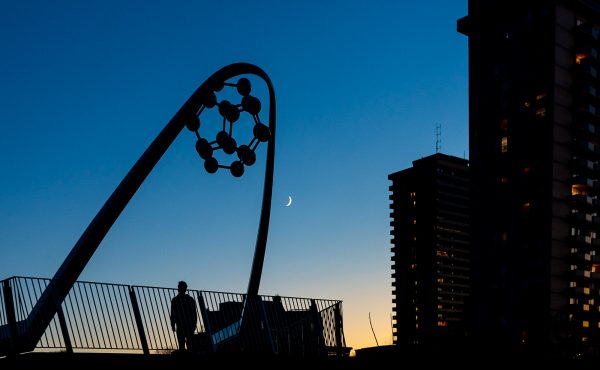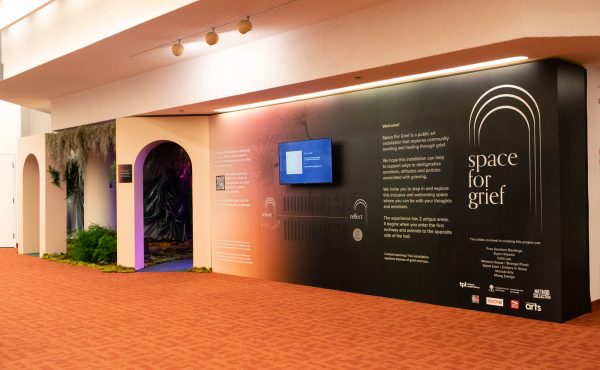
In this week’s Eye Weekly my Psychogeography column is dedicated to wandering the bungalow and skyscraper skyline of Willowdale in North York but with the added bonus that a major art installation on Leona Drive is temporarily located a five minute walk from the Yonge-Sheppard subway station. “The Leona Drive Project” is six postwar bungalows slated for demolition that have been converted into art and archival pieces by over a dozen artists.
Two blocks east of Yonge is Leona Drive, where a bungalow painted green stands out like a real-life Monopoly house, part of the Leona Drive Project, a temporary large-scale art installation taking over six 1950s bungalows that will soon be demolished to make way for newer, shinier housing. The vacant houses, interpreted and transformed by over a dozen artists, explore the deep territory of this suburban landscape, the one we’re led to believe (at least by popular mythology) has no worthwhile stories and isn’t interesting.
It’s a remarkable project by the collectives Public Access Collective and L.O.T.: Experiments in Urban Research. The green house is by artist An Te Liu, and though made of solid brick, wood and plaster, a simple paint job renders the house plastic-seeming, as if it really is as disposable as we are treating it. Next door, Daniel Borins and Jennifer MarmanBlue Velvet view of the tranquil suburbs, where the very instrument that gave rise to this kind of development later destroys it. have impregnated a living room window with a white Honda Civic, evoking a common late-night news story where an errant car drives up over a lawn and crashes into a house, a David Lynch—
Janine Marchessault, one of the project curators and a professor at York University, says the municipal strike over the summer actually made this project possible, as it delayed the destruction of the homes. Cobbling together various small arts grants (to a total of around $50,000) and many in-kind donations, Marchessault and her colleagues’ greatest work of art may have been getting a developer to agree to the project. “The risk for him was if this project caused people to take too much of an interest in these houses,†explains Marchessault. It’s also a massive coordinating effort as the houses aren’t traditional art spaces. While we chatted, one of her workers interrupted and described a “non-lethal†gas leak that needed to be attended to.
Read the rest of the column over at Eye. You can also read about it on the (new-ish) Toronto meta-media site Mondoville. Details about the launch event:
WHEN: October 22-31 Open 1-4 and 6-9pm each day.
OPENING: Friday October 23 7-11pm w Pleasure Dome film screening at 9pm.
WHERE: 17 Leona Drive, two blocks east of Yonge, south of Sheppard East




5 comments
There was also an article on this in yesterday’s (Wednesday’s) Star.
I grew up on Mckee Avenue in the heart of Willowdale and my mom worked at a donut shop at Sheppard and Willowdale Avenue. Most of the bungalows in our part are know horrible McMansion’s that began as Hong Kong money moved there in the mid 80’s. There is only one or two original homes left on McKee. The house I grew up in is exactly the same model as the one with the car, interesting because at the corner of Bayview and McKee there was a house that cars kept driving into although not as dramatically as installation. When I think of those bungalows I think of a time when people lived in modest homes and saved their money, a time of more pragmatic expectations. If you want Shawn I can send you a shot of me in front of my bungalow.
Thanks for the thoughts Scott — if you’ve got the picture up on Flickr, we could easlily pop it in here.
The installations in house #9 were fabulous. i hope more people get to venture out and see some fantastic installation pieces.
Don’t miss it.
I also grew up near Mckee. Love the new “monster homes replacing the badly built home of the late forties and early fifty. This country has six to seven months of lousy weather. That why you want most of your land inside. The bugalows of the forty were a wish that north be a small English village and not a canadian city. I am sorry that those “nasty” Chinese upset the WASP sensibliites but they may have been the greasest thing that happen to Toronto in the nineties